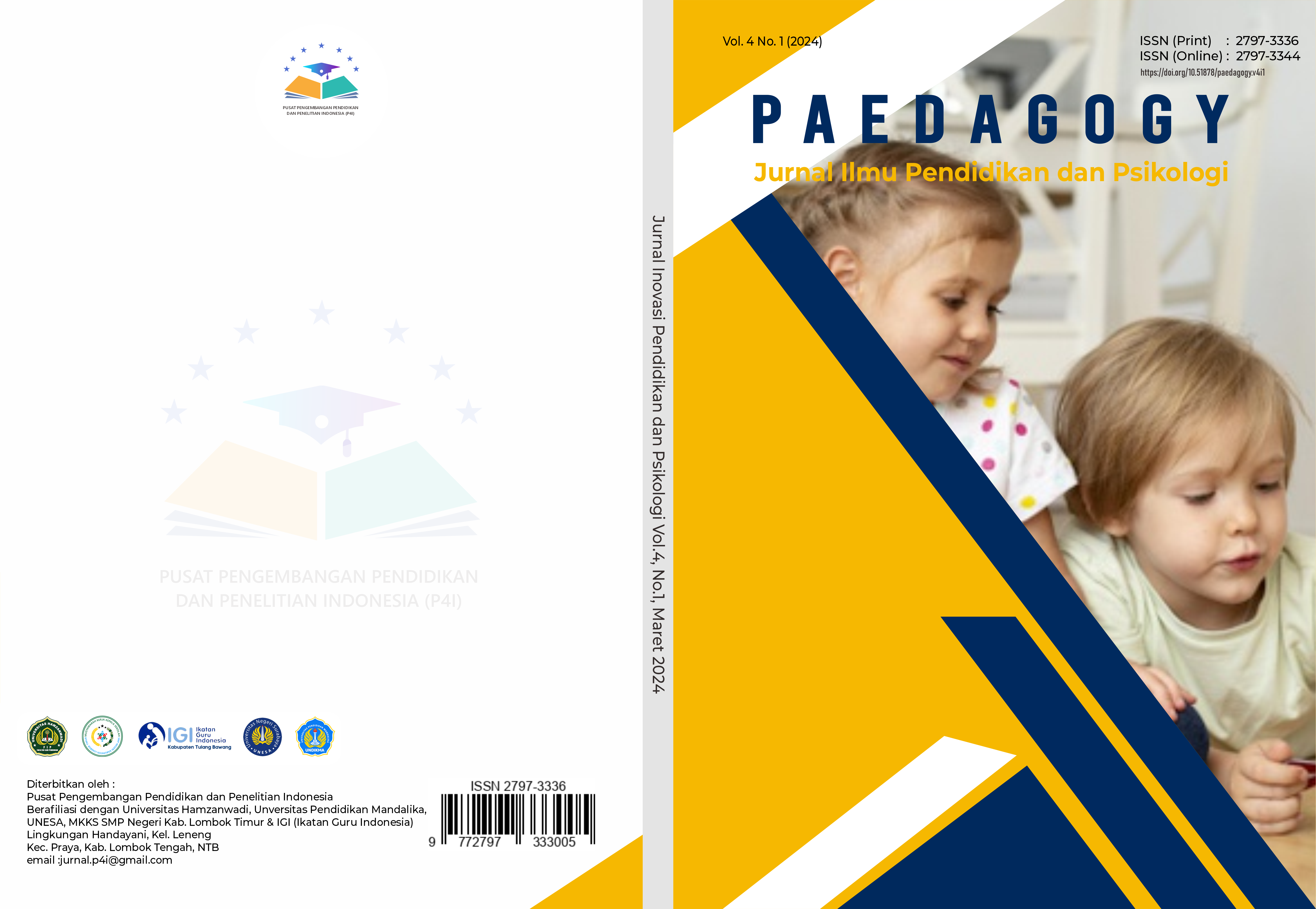EMPATI, KUALITAS PERTEMANAN DAN CYBERBULLYING PADA REMAJA AKHIR PENGGUNA TIKTOK
DOI:
https://doi.org/10.51878/paedagogy.v4i1.2756Keywords:
empati, kualitas pertemanan, perundunganAbstract
The increasingly rapid development of information and communication technology has had both positive and negative impacts, one of which is the emergence of the phenomenon of cyberbullying as a negative impact of this development. This study aims to determine the influence of empathy and friendship quality on cyberbullying in late adolescent TikTok users. This research involved 103 late teenage TikTok users. The sampling technique was determined using a non-probability sampling technique, namely purposive sampling, with the criteria of late teens using TikTok. Data collection in this research used a questionnaire method. The results of this study show that there is an influence between empathy and friendship quality on cyberbullying of 0.349 (p<0.05). This research shows that empathy has a greater influence than the quality of friendship.
ABSTRAK
Berkembangnya teknologi informasi dan komunikasi yang semakin pesat, memberikan dampak positif dan negatif, salah satunya muncul fenomena cyberbullying sebagai dampak negatif dari perkembangan tersebut. Penelitian ini bertujuan untuk mengetahui pengaruh empati dan kualitas pertemanan terhadap cyberbullying pada remaja akhir pengguna TikTok. Penelitian ini melibatkan 103 orang remaja akhir pengguna TikTok. Teknik pengambilan sampel ditentukan dengan teknik non-probability sampling yaitu purposive sampling, dengan kriteria remaja akhir yang menggunakan TikTok. Pengumpulan data pada penelitian ini menggunakan metode kuesioner. Hasil penelitian ini menunjukkan bahwa terdapat pengaruh antara empati dan kualitas pertemanan terhadap cyberbullying sebesar 0,349 (p<0.05). Penelitian ini menunjukkan bahwa empati memiliki pengaruh yang lebih besar dibandingkan kualitas pertemanan.
Downloads
References
Adiyanti, M. G., Nugraheni, A. A., Yuliawanti, R., Ragasukmasuci, L. B., & Maharani M. (2019). Emotion regulation and empathy as mediators of self-esteem and friendship quality in predicting cyberbullying tendency in Javanese-Indonesian adolescents. International Journal of Adolescene and Youth. 25(1). 251-263.
Ang, R. P. & Goh, D. H. ( 2010). Cyberbullying among adolescents: the role of affective and cognitive empathy, and gender. Child Psychiatry Human Development. 41. 387-397.
Angelita, Meirexia. A. (2023). Hubungan antara empati dan kematangan emosi dengan perilaku cyberbullying remaja di media sosial twitter. Universitas Muhammadiyah Surakarta. https://eprints.ums.ac.id/108443/1/Naskah%20Publikasi.pdf
Antoniadou, N. & Kokkinos, C. M (2018), Empathy in traditional and cyberbullying/victimization involvement from early to middle adolescence: a cross sectional study. Journal of Educational and Developmental Psychology. 8(1). 153-161.
Aoyama, I., Saxon, T. F., Fearon D.D. (2011). Internalizing problems amon cyberbullying victims and moderator effects of friendship quality. Multicultural Education & Technology Journal. 5(2), 92-105.
Balakrishnan, V., & Fernandez, T. (2018). Self-esteem, empathy and their impacts on cyberbullying among young adults. Telematics and Informatics. 35(7). 2028-2037.
Buelga, S., Postigo, J., Ferrer, B. M., Cava, M. J. & Baron, J. O. (2020). Cyberbullying among adolescents: psychometric properties of the CYB-AGS cyber-aggressor scale. International Journal of Environment Research and Public Health. 17(9). 3090.
Bukowski, W. M., Hoza, B. & Boivin, M. (1994). Measuring friendship quality during pre- and early adolescence: the development and psychometric properties of the friendship qualities scale. Journal of Social and Personal Relationship. 11. 471-484.
Burton, K. K. (2013). The Role of Peer Attachment and Normative Beliefs about Aggression on Traditional Bullying and Cyberbullying. Psychology in the Schools, 50 (2), 103-115.
Dewi & Christina. (2023). Indonesia Nomor 1 Negara Dengan Kasus Cyberbullying Terbanyak Di Dunia, Etika Berjejaring: Jarimu Harimaumu!. Bernas.ID.
Earlyana, Q. T. & Kusdiyati, S. (2023). Pengaruh problematic internet use terhadap perilaku cyberbullying pada remaja akhir pelaku cyberbullying. Bandung Conference Series: Psychology Science. 3(1). 168-175.
Elizabeth B. (2011). Psikologi Perkembangan : Suatu Pendekatan Sepanjang Rentang Kehidupan. Jakarta : Erlangga
Patchin, J. W., & Hinduja, S., (2015). Bullying Beyond the Schoolyard: Preventing and Responding to Cyberbullying. Corwin Press
Rizkyanti, C., Cahyanu, A., Salsabila, S., & Aulia, A. (2021). Empati Dan Peran Bystander Dalam Cyberbullying: Family Communication Pattern Sebagai Mediator. Jurnal Psikohumanika. 13(2), 10-24.
Spreng, R. N., McKinnon, M. C., Mar, R. A. & Levine, B. (2009). The toronto empathy questionnaire: scale development and initial validation of a factor-analytic solution to multiple empathy measures. J. Pers. Assmt. 91(1). 62-71.
Sumarlin. (2019). Hubungan Antara Keluarga dan Peer Group (Teman Sebaya) dengan Perilaku Cyberbullying pada Peserta Didik SMA Negeri di Kabupaten Luwu. Jurnal Commercium: Kajian Masyarakat Kontemporer. 2(2), 17-28.
Yonatan & Agnes. Z. (2023). Indonesia Peringkat 4, Ini Dia 7 Negara Pengguna Internet Terbesar di Dunia. GoodStats. https://data.goodstats.id/statistic/agneszefanyayonatan/indonesia-peringkat-4-ini-dia-7-negara-pengguna-internet-terbesar-di-dunia-FLw6V.
Downloads
Published
How to Cite
Issue
Section
License
Copyright (c) 2024 PAEDAGOGY : Jurnal Ilmu Pendidikan dan Psikologi

This work is licensed under a Creative Commons Attribution-NonCommercial-ShareAlike 4.0 International License.
















